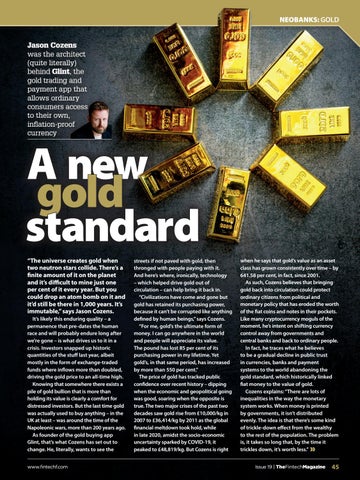NEOBANKS: GOLD Jason Cozens was the architect (quite literally) behind Glint, the gold trading and payment app that allows ordinary consumers access to their own, inflation-proof currency
A new gold standard “The universe creates gold when two neutron stars collide. There’s a finite amount of it on the planet and it’s difficult to mine just one per cent of it every year. But you could drop an atom bomb on it and it’d still be there in 1,000 years. It’s immutable,” says Jason Cozens. It’s likely this enduring quality – a permanence that pre-dates the human race and will probably endure long after we’re gone – is what drives us to it in a crisis. Investors snapped up historic quantities of the stuff last year, albeit mostly in the form of exchange-traded funds where inflows more than doubled, driving the gold price to an all-time high. Knowing that somewhere there exists a pile of gold bullion that is more than holding its value is clearly a comfort for distressed investors. But the last time gold was actually used to buy anything – in the UK at least – was around the time of the Napoleonic wars, more than 200 years ago. As founder of the gold buying app Glint, that’s what Cozens has set out to change. He, literally, wants to see the www.fintechf.com
streets if not paved with gold, then thronged with people paying with it. And here’s where, ironically, technology – which helped drive gold out of circulation – can help bring it back in. “Civilizations have come and gone but gold has retained its purchasing power, because it can’t be corrupted like anything defined by human beings,” says Cozens. “For me, gold’s the ultimate form of money. I can go anywhere in the world and people will appreciate its value. The pound has lost 85 per cent of its purchasing power in my lifetime. Yet gold’s, in that same period, has increased by more than 550 per cent.” The price of gold has tracked public confidence over recent history – dipping when the economic and geopolitical going was good, soaring when the opposite is true. The two major crises of the past two decades saw gold rise from £10,000/kg in 2007 to £36,414/kg by 2011 as the global financial meltdown took hold, while in late 2020, amidst the socio-economic uncertainty sparked by COVID-19, it peaked to £48,819/kg. But Cozens is right
when he says that gold’s value as an asset class has grown consistently over time – by 641.58 per cent, in fact, since 2001. As such, Cozens believes that bringing gold back into circulation could protect ordinary citizens from political and monetary policy that has eroded the worth of the fiat coins and notes in their pockets. Like many cryptocurrency moguls of the moment, he’s intent on shifting currency control away from governments and central banks and back to ordinary people. In fact, he traces what he believes to be a gradual decline in public trust in currencies, banks and payment systems to the world abandoning the gold standard, which historically linked fiat money to the value of gold. Cozens explains: “There are lots of inequalities in the way the monetary system works. When money is printed by governments, it isn’t distributed evenly. The idea is that there’s some kind of trickle-down effect from the wealthy to the rest of the population. The problem is, it takes so long that, by the time it trickles down, it’s worth less.” Issue 19 | TheFintechMagazine
45
